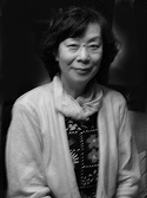Moto Hagio
Moto Hagio ( Japanese 萩 尾 望 都 , Hagio Moto ; born May 12, 1949 in Fukuoka Prefecture , Japan ) is a Japanese manga artist . She is considered to be one of the first women to address issues such as homosexuality ( shōnen ai ) and science fiction in her manga for girls ( shōjo ) . For these activities she is counted among other things, alongside Riyoko Ikeda and Keiko Takemiya, in the group of 24 . The main characters in their comics are almost always boys.
Career
Hagio showed artistic ability at a very young age and decided to become a manga artist when she was reading Osamu Tezuka's manga Shinsengumi at high school . Her career began in 1969 with her first publication, the short story Ruru to Mimi , which appeared in Japanese girls' magazine Nakayoshi . However , she turned away from this manga magazine after a short time because she was not allowed to broach the topics that would later make her famous.
For magazines such as COM and Garo , she drew several short stories in the early 1970s, including the first Shōnen-Ai -Manga, 11-gatsu no Gymnasium . Through her friend and roommate Keiko Takemiya ( Kaze to Ki no Uta ) she came to the Shogakukan publishing house in 1972 and published her first long manga there, which also became her first great success - Poe no Ichizoku . In this work she told of a family of vampires, she ended the 500-page story in 1976. With manga like Thomas no Shinzō , another Shōnen-Ai-Manga, 11-nin Iru! and Marginal , two science fiction manga, became hugely popular with both readers and critics in the 1970s and 1980s. From 1992, her Zankoku na Kami ga Shihai suru , an epic in 17 volumes, was published. She worked on Barbara Ikai from 2002 to 2005. The series Koko dewanai Doko ka (also Anywhere But Here ) has been published since 2006 and between 2008 and 2010 Leo-kun has also been published .
Awards
Hagio received several prizes for her work, including the Shogakukan Manga Prize for 11-nin Iru! and Poe no Ichizoku , the first Osamu Tezuka culture award for Zankoku na Kami ga Shihai suru and three times the Seiun award for outstanding science fiction manga. In 2016 she was awarded an Asahi Prize .
In 2012 she was the first female mangaka to receive the Japanese Medal of Honor on the Violet Ribbon, which is awarded to outstanding artists.
Works (selection)
- Ruru to Mimi ( ル ル と ミ ミ ), 1969
-
Seirei series, 1971–1974
- Seireigari ( 精 霊 狩 り )
- Door no Naka no Watashi no Musuko ( ド ア の 中 の 私 の 息 子 , Doa ~ )
- Minna de Ocha o ( み ん な で お 茶 を )
- 11-gatsu no Gymnasium ( 11 月 の ギ ム ナ ジ ウ ム , 11-gatsu no Gimunajiumu ), 1971
- Poe no Ichizoku (ポ ー の 一族 , Pō no Ichizoku ), 1972–1976
- Tottemo Shiwase Moto-chan ( と っ て も し あ わ せ モ ト ち ゃ ん ), 1972–1976
- Thomas no Shinzō (ト ー マ の 心 臓 , Tōma no Shinzō ), 1973-1975
- 11-nin Iru! ( 11 人 い る! ), 1975–1976
- Alois ( ア ロ イ ス , Aroisu ), 1975
- Hyakuoku no Hiru to Sen'oku no Yoru ( 百億 の 昼 と 千億 の 夜 ), 1977–1978
- Star Red ( ス タ ー ・ レ ッ ド , Sutā Reddo ), 1978–1979
- Mesh ( メ ッ シ ュ , Messhu ), 1980–1984
- Hōmonsha ( 訪問者 ), 1980
- A-A ' / 4/4 Quatre-Quarts ( 4/4 カ ト ル カ ー ス , 4/4 Karoru Kāsu ) / X + Y , 1981–1984
- Hanshin ( 半 神 ), 1984
- Marginal (マ ー ジ ナ ル , Mājinaru ), 1985–1987
- Flower Festival ( フ ラ ワ ー フ ェ ス テ ィ バ ル , Furawā Fesutibaru ), 1988–1989
- Aoi Tori ( 青 い 鳥 ), 1989
- Umi no Aria ( 海 の ア リ ア ), 1989–1991
- Roma e no Michi ( ロ ー マ へ の 道 ), 1990
- Abunai Oke no Ie ( あ ぶ な い 丘 の 家 ), 1992–1994
- Zankoku na Kami ga Shihai suru (残酷 な 神 が 支配 す る ), 1992–2001
- Barbara Ikai ( バ ル バ ラ 異界 , Barubara Ikai ), 2002–2005
- Koko dewanai Doko ka ( こ こ で は な い ★ ど こ か ), 2006–
- Leo-kun ( レ オ く ん , Reo-kun ), 2008–2010
Web links
- Interview with Hagio, conducted by Matt Thorn ( Memento from May 24, 2008 in the Internet Archive )
Individual evidence
- ↑ Hagio Is 1st Female Manga Creator to Win Japan's Purple Ribbon. In: Anime News Network. April 27, 2012, accessed April 28, 2012 .
| personal data | |
|---|---|
| SURNAME | Hagio, Moto |
| ALTERNATIVE NAMES | 萩 尾 望 都 (Japanese) |
| BRIEF DESCRIPTION | japanese mangaka |
| DATE OF BIRTH | May 12, 1949 |
| PLACE OF BIRTH | Fukuoka Prefecture , Japan |
